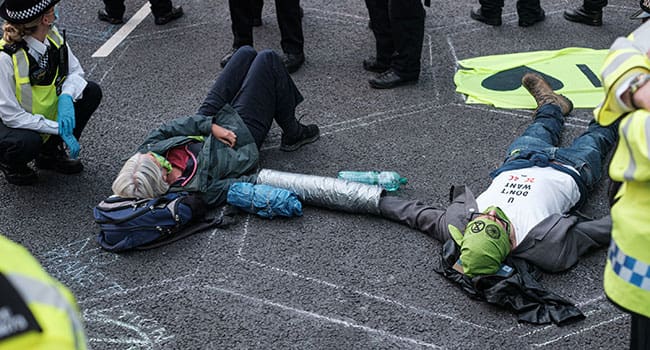 By now it should be abundantly clear that violent extremism is not just a trait of Islamists or the far right. Black Lives Matter and Antifa riots have resulted in dozens of deaths this year, multiple police officers wounded and blinded, and entire districts of American cities burned down in the name of racial justice.
By now it should be abundantly clear that violent extremism is not just a trait of Islamists or the far right. Black Lives Matter and Antifa riots have resulted in dozens of deaths this year, multiple police officers wounded and blinded, and entire districts of American cities burned down in the name of racial justice.
Despite this, political leaders appear unwilling to even acknowledge this is happening.
Democratic president-elect Joe Biden said on Sept. 29 that Antifa, the revolutionary communist organization responsible for violence throughout Europe and North America, was merely an “idea.”
It’s bad enough that violence destroying the lives of innocent people is being routinely ignored by those who consider it politically inconvenient. Now other radical movements are using equally radical tactics to disrupt and incite terror without meeting the typical expectations of traditional extremist and terrorist organizations.
Extinction Rebellion, the climate alarmist group, has redefined activism in an extreme way while expertly manoeuvring around accusations of extremism and terrorism. When British counter-terrorism police included Extinction Rebellion on a list of extremist ideologies, backed by Home Secretary Priti Patel, the organization threatened legal action and received an outpouring of support. Patel’s support for the decision was branded “indefensible” by the Labour Party.
Extinction Rebellion’s cult-like threat to society by Marco Navarro-Genie
A spokesperson for Extinction Rebellion also pointed to Mark Carney, the former governor of both the Bank of England and Bank of Canada, who has warned that climate change is a threat to global financial security.
Globally, Extinction Rebellion is praised, Greta Thunberg idolized and given speaking time by the United Nations, and the movement is a fixture in popular culture and supported by huge numbers of young, left-leaning students.
Extinction Rebellion has established itself as a mainstream group with the support of politicians and celebrities by combining disruptive yet clever tactics, and adopting existing popular messaging. Much in the same way that far-right extremists prey on the legitimate grievances of the white working class, Extinction Rebellion has latched onto the existing narrative around climate change while upping the ante.
Climate alarmism was already common before Thunberg entered the stage, giving the organization scope to be more radical in their messaging and activism. In the same way that opposition to Antifa can be decried as fascism, simply because the name implies their opponents are all fascists, critics of Extinction Rebellion’s tactics are easily dismissed by the group as climate change deniers.
With that armour, the organization has gone about implementing a new climate of panic, by intimidating people in the streets, bringing cities to a standstill, and co-opting every major headline or crisis for their own gain.
Dancing in the street is obviously hard to describe as terrorism, but the unseen effects of the group’s street activism form an undercurrent of intimidation and fear. It’s the same kind of intimidation and fear that terrorists incite in periods between violent attacks.
In Australia in October 2019, a woman broke down in tears after climate activists stopped a woman reaching her family home just days after her mother passed away.
In London that same month, Extinction Rebellion protesters blocked one of London’s bridges, forcing a cancer patient to get out of the car and walk to her treatment. “20 mins might not sound long but when u have CANCER IT IS!” the patient, Adeline Aedji, wrote online.
In September of this year, an ambulance on an emergency call was blocked by climate protesters who brought the Westminster area to a standstill.
In British Columbia in February, three protesters were arrested after sitting in the driveway of Premier John Horgan’s home, banging on his door and proclaiming that they intended to perform a citizen’s arrest.
Dancing (or lying down) while they do it, Extinction Rebellion activists cause disruption in the daily lives of people in major cities with no regard for the health, safety or well-being of anybody around them. For them, cancer patients and people waiting on emergency medical care are mere collateral damage for a climate that, they say, is on the brink of disaster.
It’s smiley-face terrorism.
At some point, the impact that this kind of activism has on people’s lives must be addressed.
Just as far-right groups use legitimate grievances surrounding immigration and identity, Extinction Rebellion feeds on climate change fears and incites greater panic with its relentless disruption.
Isn’t it about time we began addressing underlying grievances behind extremist groups, undercutting their ability to capitalize on those fears?
Jack Buckby is a research associate with Frontier Centre for Public Policy.
Jack is a Troy Media Thought Leader. Why aren’t you?
For interview requests, click here. You must be a Troy Media Marketplace media subscriber to access our Sourcebook.
The views, opinions and positions expressed by columnists and contributors are the author’s alone. They do not inherently or expressly reflect the views, opinions and/or positions of our publication.

